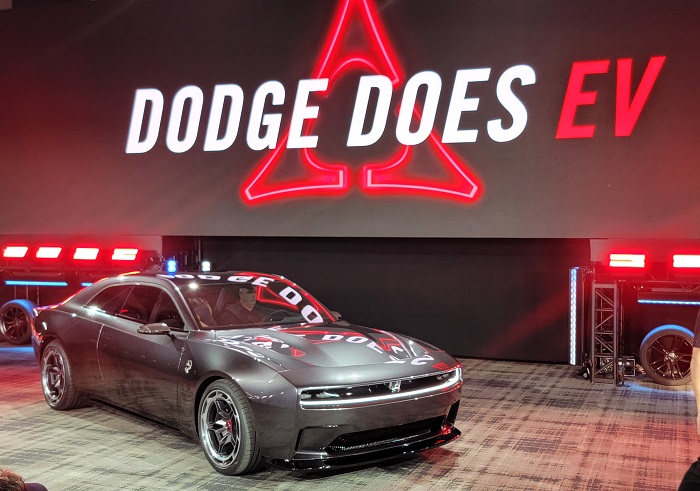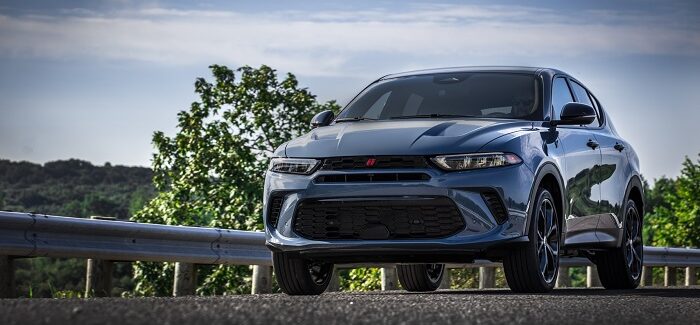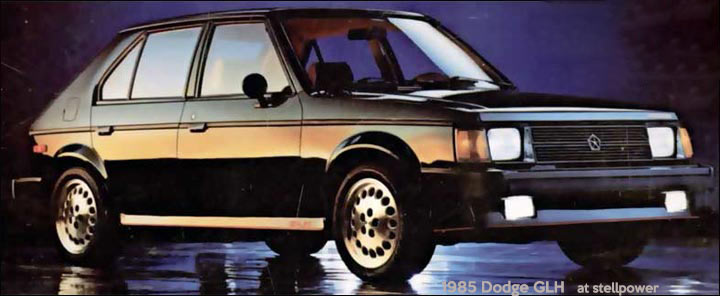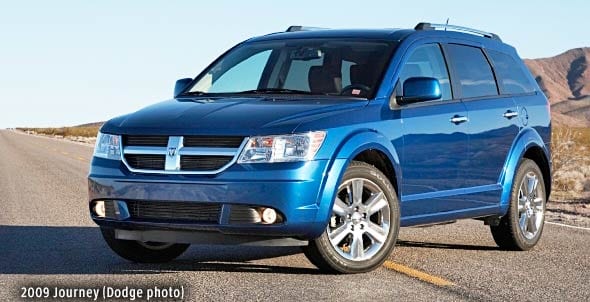The auto industry is going through a major time of transition, especially at Mopar, with the end of the Hemi V8s, the birth of EVs, and muscle car rivals switching to electric or hybrid variants with historic names—not to mention making crossovers with coupe names.

Dodge has been pouring out more smoke than a 1,000-car Hellcat burnout competition, and breaking hearts with the news that not only are the V8 engines going away, but also the Challenger and Charger “as we know them.” There are rumors that the ultimate American muscle SUV is moving to a truck-based STLA-Frame platform, which leaves many worrying about what is to become of the mighty Mopar.
Sedans and coupes are dying breeds, along with those musical V8 powerplants; they are being replaced by SUVs and crossovers and pickups. These are markets where Dodge is not really playing now, outside of the Durango. How does the muscle brand hope to survive in this new world? Tim Kuniskis referenced the hammerhead shark: evolution. It isn’t as cut and dried, though.
The Hornet crossover signals that Dodge is branching out into new territory though still using styles pioneered by the Chargers. The racetrack taillamps, aggressive front fascia, scooped hood, and headlamps are all evolved from the design of the Charger (and all the more impressive given that the body is Alfa Romeo’s take on the Jeep Compass).

Dodge is also digging into its history, as evidenced partly by the GLH tag. Other names could do some cool new things, while allowing the high-performance muscle aura. That includes the Magnum, Journey, and Nitro names, along with Caravan, Dakota, and Durango. These could the Dodge’s path to success into new segments while retaining their image.

That brings us back to the Durango, which rumors claim is moving to STLA Frame using Hurricane engines and an 800V BEV variant.
The Ram BEV concept showcased many ideas that could be in a big pickup-based SUV. A Durango Power Wagon could take advantage of Ram Rebel features. A Durango Ramcharger could be a king-of-the-hill all-terrain package, based as much as possible on the Ram TRX and with the attitude of a Charger—or, perhaps, a less powerful Durango Ramcharger R/T, with R/T standing for Road and Trail rather than Road and Track.
An STLA Frame Durango could match every Ram 1500 trim level; and there would be ICE, hybrid, and BEV versions to diversify the truck and help it compete in several markets.
Having Durango join Wagoneer in the body-on-frame world would leave a void in the non-Jeep Mopar lineup, where they face the Ford Explorer. Here, STLA Large shines.
The Banshee concept let us know that Dodge realizes they need to produce vehicles that do more than just go fast and offer people comfort; they need to be versatile and offer cargo capacity as well, which is why they made a huge deal about the EV acting like a UV.

Dodge used to have a solution for people who wanted a performance sedan with some cargo space—the Dodge Magnum. The wagon was based on the Chrysler 300 sedan. Visibility wasn’t the best and cargo space could have been improved, but it was a step in the right direction.
Dodge could re-create the Magnum to be a bit more of a blend of Charger and Durango, taking a few of the Aero cues such as the Banshee concept’s front R-Wing, the floating rear wing and Flying buttresses of the Wagoneer-S concept, the Banshee’s coke-bottle shape, the scalloped doors from the current Chargers, racetrack tail-lamps, and a few other things, and have a 5-seater, 4-door wagon that gives enthusiasts the performance of a muscle sedan with the utility of a UV. They could not do that with the original Magnum because of plant restrictions, but making the new Magnum in Windsor would solve that.
The interior concept from the Banshee would work well, as would a Direct Connection performance packs and upgrades. Models would likely include:
- 2.0L 4xe SXT
- Standard-output Hurricane-powered GT
- High-output Hurricane-powered R/T
- Cat-3 Hurricane GLH
- Hybrid Hurricane GTX
- 800V top of the line SRT
Stepping up from that would be a rugged, squared-off Dodge Nitro SUV with just one powertrain, the 4xe, to help with CAFE ratings. The squared off look provides more cargo space. A Nitro-X version could compete with lifestyle vehicles like the Santa Cruz and Maverick, but with far more power. The top end of this line would be the Nitro 340 R/T EV variant with a 340Kw AWD EV powertrain, adding storage where the engine no longer had to be.

Above the Nitro would be the Dodge Journey, slotting into the spot the Durango would leave if it moved to a full frame platform. The Journey would compete more directly with the Explorer, with engine options similar to the lower-profile Magnum wagon/crossover. With an 800V tri-motor top end, it could outperform anything in its class, with the cargo/passenger space of a Grand Cherokee L. It could revive the Crossroads package as its all-terrain variant.
Next in line would be the return of the Dodge Caravan and Grand Caravan. Based on the Pacifica replacement, they would have the utility of a minivan with the look of an SUV.
The 1970s Dodge B-series vans had “Street Van” packages; these would return, bringing a new lease on the minivan life. The lower center of gravity and RWD-based AWD powertrain should bring greater safety and handling, while the new platform could allow both hybrid and EV power.
Finally, we have the Ranger/Colorado/Tacoma/Ridgeline-fighting Dodge Dakota pickup (now rumored to be showing up as the Ram 1200). Tow ratings of vehicles in this class range fromm 5,000 to 7,500 pounds. This would be a unibody truck, with towing in the middle of that range. Engines would range from the 2-liter hybrid up to the Hurricane, and above that at least the 340kW EV setup.
That only covers STLA Large; they also have Medium and Small. STLA Medium could see some amazing vehicles that could be volume sellers. It sits in the center of mini crossovers like the RAV4, and can also provide compact performance. A second-generation Hornet GLH with 320hp would easily keep with the performance/practicality theme of the first generation.

A few Direct Connection stage packages would truly bring back the original SRT4/GLH vibes that made the brand stay awesome during the years when they lacked V8 muscle cars. The GLH and the SRT4 lineup proved that Dodge did not need V8s to have performance.
Dodge has become the brand of performance, no matter what size engine is under the hood. With this new Hurricane 3.0L putting out over 500hp, what could they do with stroked or hybrid versions? We could easily see some efficient ICE powertrains that make Hellcat type numbers all over again with insane levels of torque, smooth operation, and longevity on top of that. They’d make great powertrains for Ram 1500 and maybe even Ram 2500 6.4L replacements as well.
While to some, this may sound a bit sacrilegious, Dodge could stand to take a look at what some of the overseas tuner brands did back in the mid to late ‘90s with their inline-six twin turbo engines, not only with performance, but with styling. I can understand Dodge wanting to ensure that their cars are tuned properly, but instead of cutting tuners out, maybe it’s time to include more of them inside. This draws enthusiasts in, despite the fact that they’re dropping V8s and adding EVs.
As long as Dodge can continue on being the cool performance brand it has become and stay relevant in this new environment, that’s really all that matters.
Discover more from Stellpower - that Mopar news site
Subscribe to get the latest posts sent to your email.
